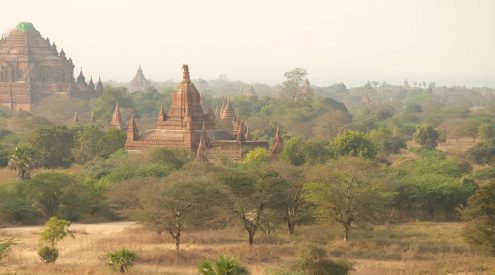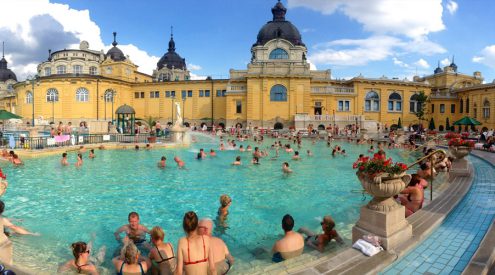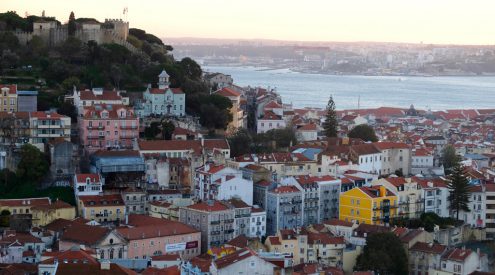I went in search of the djinns (spirits) of Old Delhi.
We were swept along by a tide of devotees through the narrow alleyways of the bazaar. After buying a handful of rose petals to sprinkle on the tomb of Saint Nizamuddin, a Sufi sage who died in 1352, we left our shoes in the safekeeping of one of the many stallholders. Covering our heads with scarves, we joined the large crowd of worshippers in the temple courtyard. Behind a dividing screen, women wailed at the tomb of the daughter of Shah Jahan, builder of the Taj Mahal.
We’re divided into women on one side – and men on the other. The leader of the band invites me to sit down next to him on the podium. The crowd opens like the red sea to make space for me. We fall under the hypnotic spell of the qawwali band who are chanting devotional prayers, drumming tablas and hand-pumping harmoniums. We’re made to feel very welcome as the only tourists at the Sufi Sunday service. I’m even invited into the men-only inner shrine where I sprinkle petals on the saint’s tomb, circle the shrine – and help to cover it with layers of holy veils offered by worshippers.
India is intoxicating, a spiritual smorgasbord of all the major religions from east to west. Beneath the golden domes of the Sikh temple of Gurdwara Sahib we come face to face with the holy khalsa brotherhood who carry all their worldly belongings on a spiritual journey around the country in a crusade for righteousness. These soldier-saints wear giant white turbans and sacred orange scarves. These lions of the Sikh faith observe five kakkars (symbols) of saintliness – wear unshaven beards and uncut hair, carry a comb to keep it neat, loose underwear as a symbol of modesty, and carry a sabre and steel bangles. (I almost qualify as a soldier saint – except for the sword!)
On our spiritual tour of Old Delhi, we also explored Jama Masjid – the oldest mosque in India (1658) – a landmark with giant red sandstone gates, towers and a courtyard which holds 25 000 worshippers. The faithful were washing themselves in the giant fountain in the middle of the complex. If you pay a few rupees to climb the tall minaret you’re rewarded with amazing views of the red fort – the symbol of Old Delhi built by Shah Jahan, the mogul emperor who also built the Taj Mahal in nearby Agra.
The incredible spiritual tapestry of India has attracted many tourists since the 1960s. Spiritual tourism is a growing phenomenon. We are undertaking a fascinating journey with Cecelia Amory, a South African travel operator from Champion Tours who takes visitors on an escorted two-week “spiritual journey” to share and experience the ancient temples, mosques and shrines of India – and participate in the ceremonies.
Some call India a spiritual supermarket – there are so many sects and religions. Some of the world’s oldest religions are practised in India today – the Zoroastrianism of the Parsees in Mumbai, Islam, the Sufis, Christianity, Buddhism, the majority Hinduism, Jains, Sikhs and Bahai. They say there are over a million gods in different incarnations in India – it is a very traditional, religious society where you see every household offering puja (prayer) every day on the streets and at the river ghats.
Apart from the temple tours, services and lunches, we also visited major tourist attractions like the red fort in Delhi – and city sights like Qutab Minar – the world’s tallest brick minaret (73m high). Built in the 12th century, the fluted red sandstone tower carved with verses from the Koran is an incredible sight in south Delhi.
We also visited Humayan’s Tomb, a UNESCO World Heritage site – built in the 16th century. Set in landscaped gardens which resemble the ornate designs of a Persian carpet, these high 50m domes and tombs are superb examples of early Mughal architecture – and the precursor to the Taj Mahal. We watched the descendants of the original artisans carving red sandstone and marble in ongoing restoration work. They still use the original mortar recipe – lime mixed with milk, yoghurt, lentils, oils, fats and fruits! You could probably lick the walls for nourishment! Where else but India?
I went vegetarian in the communal dining rooms at Sikh and Jain temples. In Chandni Chowk, on dariba kalan, one of the oldest markets in Old Delhi, we enjoyed wonderful street foods – from a century-old samoosa stall well as delicious freshly fried jalebi – squiggly orange sweets filled with syrupy sugar. We also enjoyed the wonderful thali platters at vegetarian restaurants in the Karol Bagh area – an all-you-can-eat platter of lentil dhals, vegetable and yam curries, kofta, pokara, rice, Indian breads and desserts like gulab (deep-fried balls of dough in rose syrup – almost like a koeksister!). I became addicted to the milky, spicy tea known as masala chai served everywhere – and to masala dosa, spicy wafer-thin lentil flour pancakes for breakfast.
You could spend days exploring the old markets, national museums and tourist attractions of the capital of India. One of the best ways is to take a day’s urban adventure with Intrepid Travel travelling with a tide of people who expel you out onto the platforms like a tsunami on the underground metro where men and women ride in separate carriages – on the way to doing Gandhi’s Delhi (I thought they meant deli – like a food tour of street eats!)
We visited the residence where Mahatma Gandhi stayed for the last 11 years of his life between 1939 – to his assassination here in 1948. Some of the most poignant exhibits in the museum are his simple glasses, walking stick, spinning wheel and pocket watch which stopped at the time he was shot dead in the gardens. The exhibits tell the history of his campaigns of civil disobedience in South Africa at the turn of the 19th century – and his campaigns for the untouchable caste and for independence for India. When in prison he made a pair of sandals for General Jan Smuts who returned them with a letter saying he did not feel he was worthy to wear them.
India is intoxicating. You can see why they call their tourism campaign Incredible India. Our senses are overwhelmed every moment by the kaleidoscope of colour, the brightly coloured saris and turbans, the exotic aromas of spices, all the chai, paan, tiffin, samoosa and sweet street wallahs, cycle rickshaws, tuk tuks, ox-carts, sacred stray cows in the alleys and highways, hypnotic music in ancient alleys and bazaars. I even spotted a camel parked at an internet café – while the driver surfed the net inside!
I flew from Johannesburg to India on Jet Airways (call 0860 JETAIR) and stayed at Taj Hotels, Resorts & Palaces. I travelled with www.egyptandbeyond.co.za and www.indebo.com (tel 011- 678 6165). Ceclia Amory, a South African travel operator from Champion Tours, takes visitors on an escorted two-week “spiritual journey” to share and experience the ancient temples, mosques and shrines of India (email [email protected]).
















